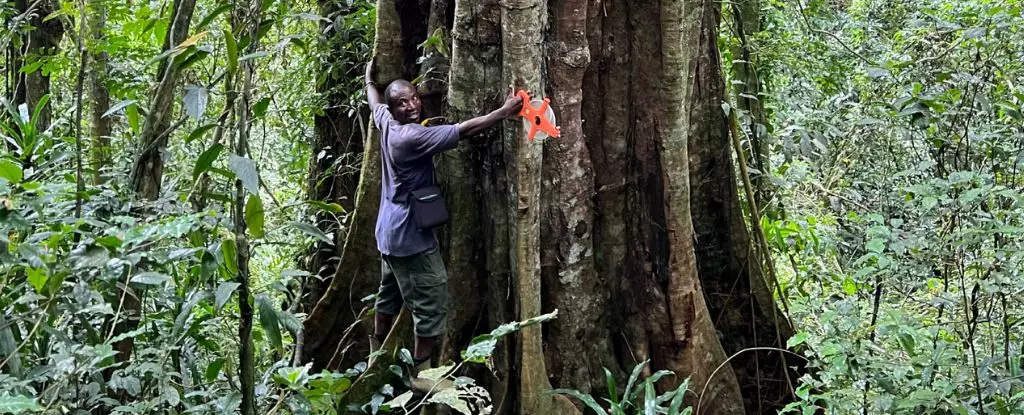In the lush expanses of Tanzania’s Udzungwa Mountains, a startling discovery has surfaced that connects deeper themes of human neglect and ecological urgency. Scientists recently unearthed an old-growth tree species, Tessmannia princeps, which could potentially inhabit our world for a staggering 3,000 years. The find, while exhilarating, rebuffs our understanding of biodiversity and plants—and also reflects our collective failures to protect such biodiversity. It was not simply a new species unveiling; it’s a sobering reminder of how much we fail to notice the wonders of the natural world while it languishes under the threat of human-induced destruction.
Brought to light by botanist Andrea Bianchi and two local experts, Aloyce and Ruben Mwakisoma, the majestic 40-meter tree flaunts a unique physicality. It challenges the notion of category, with bark that whispers pale shades and blossoms that release sweet fragrances—from a distance, it looks like a sentinel holding secrets of an ancient time. But what does it say about contemporary humans? How do we not notice such magnificent flora flourishing in our midst? It’s not merely an oversight; it speaks volumes of our disconnect and indifference to the environment.
The Ecosystem’s Silent Marquee
Tessmannia princeps serves a vital role in its ecosystem, standing tall as an “ecosystem bridge” that connects two ancient forests in Tanzania. The stark reality, however, lurks in the shadows—only around 1,000 of these remarkable trees remain, scattered precariously in two adjacent valleys. The token nature of their presence illustrates a bitter paradox—the richness of biodiversity can be both a blessing and a curse. Despite its remarkable stature and ancient lineage, this species, like so many others, faces an uphill battle against extinction.
Within humanity’s survival narrative lies an uncomfortable truth: our relentless pursuit of progress often blinds us to the beauty around us. The area housing T. princeps has suffered immensely—for over a century, vast tracts of montane forest have been stripped bare, rendering the magnificent tree’s future an unsure one. This newly discovered species stands as an emblem of resilience but simultaneously mirrors the fragility of our ecosystems. It’s an urgent reminder that unless we take immediate action, this noble entity could swiftly transition from ‘unique discovery’ to ‘forgotten relic.’
Biodiversity Under Siege
The world is experiencing an alarming decline in old-growth forests—a trend shaved down to a disheartening statistic. In just a single year—2018—nearly 4 million hectares of rainforest disappeared, roughly the size of Belgium. Such loss is not only heartbreaking but also poses a global risk to ecological health and climate stability. The nexus of human activity, infrastructure, and deforestation plays a pivotal role in this saga marked by negligence. If scientists predict that an astonishing 75 percent of undiscovered plant species are at risk of extinction, why haven’t we mobilized our efforts more aggressively to curb this disaster?
T. princeps is fortuitately one of the lucky few—a vulnerable species teetering under the weight of habitat destruction. Yet its existence poses a critical question: how many other species remain hidden, awaiting discovery, only to have their possible future snuffed out by our negligence? The old-growth configurations provided by trees like this one are essential not only for myriad fauna but also for our own survival, acting as critical carbon storage systems that are defense mechanisms against climate change.
A Call to Action
While it’s tempting to romanticize the majesty of Tessmannia princeps, we must engage with a pragmatic outlook on conservation. Protection of this tree must not solely rest in scientific observation but calls for concerted conservation efforts that entwine with local communities. Restoration projects seek to harness the dual benefit of protecting this magnificent tree whilst alleviating poverty in surrounding villages. This relationship offers a potential model for conservation efforts globally—engaging deeply with local knowledge and needs can lead to a powerful synergy between ecological and human welfare.
What is paramount is the urgency for a shift in commitment; we must have the resolve to safeguard the planet’s remaining treasures, ensuring species like T. princeps not just survive but thrive. Without concerted efforts to protect these irreplaceable ecosystems, our generations may face a dismal future devoid of nature’s ancient giants, leaving behind a scarred landscape of lost biodiversity.



Leave a Reply